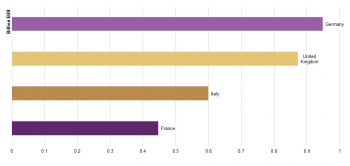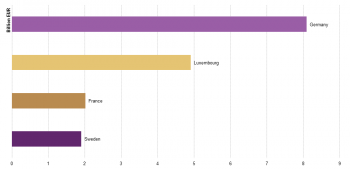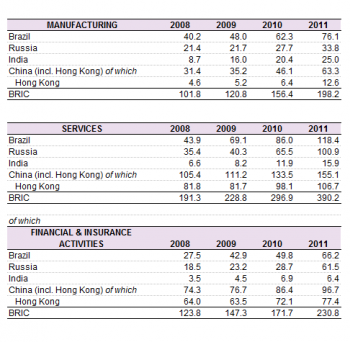Archive:Foreign direct investment between the European Union and BRIC
- Data from July 2014. Most recent data: Further Eurostat information, Main tables and Database.
This article presents foreign direct investment (FDI) between the European Union (EU) and the BRIC countries – Brazil, Russia, India and China (including Hong Kong).











Main statistical findings
FDI flows
The preliminary figures for 2013 based on annualised quarterly balance of payments data for outward FDI flows to these countries show a one third decline from the previous year, and a fall of more than half compared with the peak levels of 2010 (Figure 1). The share in total Extra-EU flows also dropped.
As regard inward flows, both absolute and relative contributions of the BRIC[1] countries to total extra EU FDI flows were less volatile during the studied period. They doubled in 2013 to minimise the gap in the bilateral FDI balance with the EU.
Over the period 2009-2013, the main BRIC destination of EU FDI flows was Brazil (EUR 146 bn), followed by China and Hong Kong combined (EUR 106 bn).
In 2013, the main EU investor in Brazil and Russia was Luxembourg[2] , while Germany dominated EU investment in India and China (including Hong Kong). France was among the top four EU investors in all BRIC countries (Figures 2a, 2b, 2c and 2d).
FDI stocks
FDI stocks held between the EU and the BRIC countries doubled between 2008 and 2012 in both directions. Similarly to FDI flows, the EU is a net investor vis-à-vis those countries (Figure 3).
In 2012, 14 % of total EU outward stocks held in extra-EU countries were located in the BRIC countries (Table 3). One third (EUR 251 bn) of these were positioned in China (included Hong Kong) and another third (EUR 247 bn) – in Brazil. The highest growth between 2008 and 2012 was recorded for India (+135 %).
In 2012, the BRIC countries held EUR 261 bn of FDI stocks in the EU, Brazil being the main partner with EUR 98 bn (Table 4). Russian FDI positions in the EU increased by 155 % during the studied period.
Table 5 shows the EU FDI stocks in BRIC countries by main activity over the period 2008-2011. Overall, the EU invested predominantly in the Service sectors. Exceptions were China (excluding Hong Kong) and India, where the Manufacturing sector held about 40 % and 60 % respectively of total EU FDI stocks in those economies at the end of 2011. The financial sector attracted more than half of EU investments in Hong Kong and one third in Russia in 2011. The latter almost tripled from 2008.
EU investments in Brazil were mainly held in the Service sector, in particular in financial services and telecommunications. Mining (including extraction of petroleum and gas) and the related manufacturing activities were also an important location of EU FDI stocks in that country.
Data sources and availability
FDI statistics in the EU are collected in accordance with Regulation (EC) No 184/2005 of the European Parliament and of the Council on Community statistics concerning balance of payments, international trade in services and foreign direct investment.
The methodological framework used is that of the OECD benchmark definition of foreign direct investment — third edition, which provides a detailed operational definition that is fully consistent with the IMF’s balance of payments manual (fifth edition).
This article is based on FDI data that were available in Eurostat’s database at the beginning of June 2014. The series in the database covered the period from 1992 to 2012, analysed by partner, activity and type of direct investment (equity capital, loans and reinvested earnings). The aggregated FDI figures that are presented in this article for 2013 are provisional data based on annualised quarterly balance of payments data.
EU aggregates include special-purpose entities, which are a particular class of enterprises (often empty shells or holding companies) not included in all countries’ national statistics. Consequently, EU aggregates are not simply the sum of national figures.
Context
In a world of increasing globalisation, where political, economic and technological barriers are rapidly disappearing, the ability of a country to participate in global activity is an important indicator of its performance and competitiveness. In order to remain competitive, modern-day business relationships extend well beyond the traditional international exchange of goods and services, as witnessed by the increasing reliance of enterprises on mergers, partnerships, joint ventures, licensing agreements, and other forms of business cooperation.
FDI may be seen as an alternative economic strategy, adopted by those enterprises that invest to establish a new plant/office, or alternatively, purchase existing assets of a foreign enterprise. These enterprises seek to complement or substitute international trade, by producing (and often selling) goods and services in countries other than where the enterprise was first established.
See also
- Balance of payments and international investment position manual (BPM6)
- Foreign direct investment statistics
Further Eurostat information
Main tables
- Balance of payments - International transactions (t_bop)
- European Union direct investments (t_bop_fdi)
Database
- Balance of payments - International transactions (bop)
- European Union direct investments (bop_fdi)
- EU direct investments - main indicators (bop_fdi_main)
- European Union direct investments (bop_fdi)
Dedicated section
Methodology / Metadata
- European Union direct investments (ESMS metadata file — bop_fdi_esms)
Source data for tables, figures and maps (MS Excel)
Other information
External links
- OECD Benchmark Definition of Foreign Direct Investment
- United Nations Conference on Trade and Development (UNCTAD) - FDI Statistics
Notes